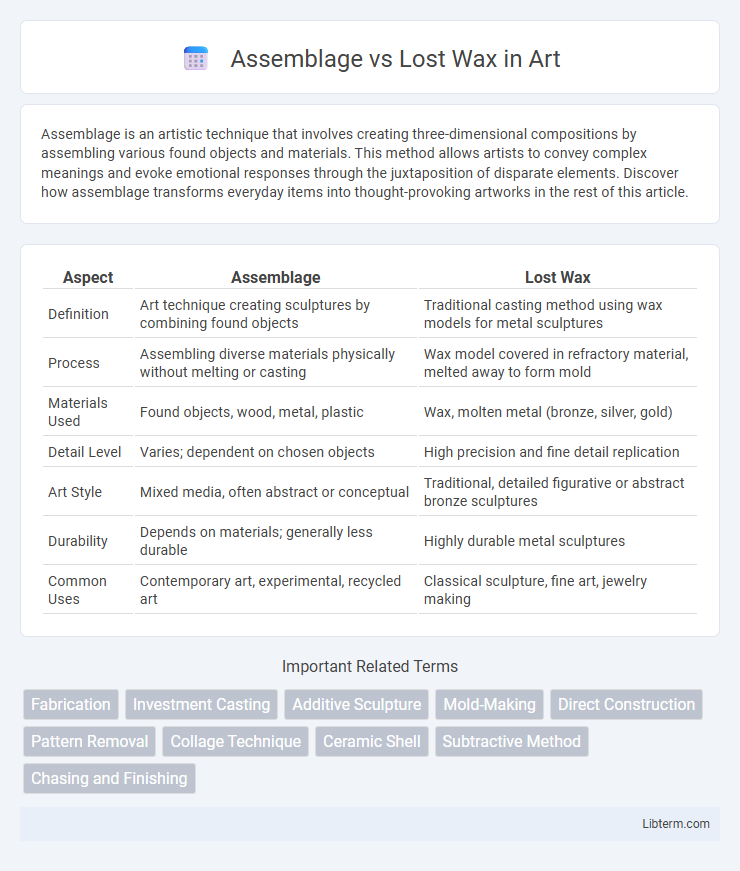Assemblage is an artistic technique that involves creating three-dimensional compositions by assembling various found objects and materials. This method allows artists to convey complex meanings and evoke emotional responses through the juxtaposition of disparate elements. Discover how assemblage transforms everyday items into thought-provoking artworks in the rest of this article.
Table of Comparison
| Aspect | Assemblage | Lost Wax |
|---|---|---|
| Definition | Art technique creating sculptures by combining found objects | Traditional casting method using wax models for metal sculptures |
| Process | Assembling diverse materials physically without melting or casting | Wax model covered in refractory material, melted away to form mold |
| Materials Used | Found objects, wood, metal, plastic | Wax, molten metal (bronze, silver, gold) |
| Detail Level | Varies; dependent on chosen objects | High precision and fine detail replication |
| Art Style | Mixed media, often abstract or conceptual | Traditional, detailed figurative or abstract bronze sculptures |
| Durability | Depends on materials; generally less durable | Highly durable metal sculptures |
| Common Uses | Contemporary art, experimental, recycled art | Classical sculpture, fine art, jewelry making |
Introduction to Assemblage and Lost Wax Techniques
Assemblage and lost wax techniques represent distinct approaches in sculpture and metalworking, with assemblage focusing on combining diverse found objects into cohesive art forms, emphasizing creativity through material juxtaposition. Lost wax, or cire perdue, is a traditional metal casting process involving sculpting a wax model, encasing it in a refractory mold, then melting the wax away to create a precise metal replica. Understanding these foundational methods reveals their unique applications in contemporary art and jewelry design, highlighting the contrast between additive construction and detailed casting precision.
Historical Background of Assemblage and Lost Wax
Assemblage art traces its origins to early 20th-century movements like Cubism and Dada, where artists began incorporating found objects to challenge traditional art forms. The lost wax casting technique dates back over 5,000 years, with origins in ancient civilizations such as Mesopotamia, the Indus Valley, and Africa, used extensively for creating detailed metal sculptures. Both methods highlight humanity's long-standing innovation in artistic expression, but Assemblage emphasizes combining everyday materials, while lost wax focuses on intricate metal casting through wax molds.
Defining Assemblage Art: Concepts and Methods
Assemblage art involves creating three-dimensional compositions by combining found objects and materials, emphasizing spatial relationships and texture. This method contrasts with lost wax casting, which is a precise metalworking technique requiring wax models to form detailed sculptures. Assemblage prioritizes conceptual layering and the recontextualization of everyday items, enhancing its narrative and symbolic depth in contemporary art.
Understanding Lost Wax Casting: Process Overview
Lost wax casting involves creating a detailed wax model that is encased in a heat-resistant ceramic shell; once hardened, the wax is melted away to form a cavity for molten metal casting. This method allows for intricate designs and high precision, making it ideal for complex jewelry or sculpture production. Unlike assemblage techniques, lost wax casting produces seamless, solid pieces from a single mold, enhancing durability and detail fidelity.
Materials Used in Assemblage vs. Lost Wax
Assemblage art primarily utilizes found objects, recycled materials, and mixed media elements such as wood, metal, plastic, and fabric to create three-dimensional compositions. Lost Wax casting depends on materials like wax for model creation, refractory investing materials for mold making, and metals such as bronze, silver, or gold for the final sculpture. The contrast lies in Assemblage's direct use of diverse, often ready-made materials, while Lost Wax involves a transformation process starting with malleable wax and culminating in metal casting.
Artistic Expression: Assemblage vs. Lost Wax
Assemblage offers artists a dynamic medium for artistic expression by combining found objects to create textured, layered sculptures that evoke personal and cultural narratives. Lost wax casting enables precise, intricate details and smooth finishes, ideal for expressing refined forms and delicate expressions in bronze or metal. Both techniques allow unique interpretations, with assemblage emphasizing conceptual depth and lost wax focusing on craftsmanship and permanence.
Technical Challenges in Each Technique
Assemblage involves precise alignment of pre-made components, demanding high skill to ensure stability without conventional adhesives or fasteners, posing challenges in securing complex structures. Lost wax casting requires meticulous wax model creation and careful mold preparation to prevent defects and ensure dimensional accuracy during metal pouring and cooling. Both techniques face distinct technical challenges: assemblage struggles with mechanical stability and intricate joins, while lost wax casting is vulnerable to mold imperfections and thermal stresses impacting final detail fidelity.
Notable Artists and Artworks
Notable artists employing the assemblage technique include Pablo Picasso, known for "Bull's Head" (1942), and Joseph Cornell, famous for his shadow boxes like "Medici Slot Machine" (1942). In contrast, lost wax casting is celebrated in the works of Auguste Rodin, whose bronze sculpture "The Thinker" (1904) exemplifies this method, and contemporary sculptor James King, recognized for intricate animal forms. These artists highlight the distinct aesthetic and technical qualities of assemblage's mixed-media constructs versus the precise bronze detail achievable through lost wax casting.
Contemporary Applications and Trends
Contemporary applications of assemblage emphasize mixed-media sculpture and found-object art, highlighting sustainability and ecological themes by repurposing materials in innovative ways. Lost wax casting remains prominent in fine jewelry and limited-edition sculptures, favored for its precision and ability to capture intricate details in metals like bronze and silver. Current trends reveal a fusion where artists integrate digital 3D modeling with traditional lost wax techniques to push boundaries in both scale and complexity.
Choosing the Right Method for Your Art
Choosing between assemblage and lost wax casting hinges on the desired aesthetic and material complexity of your artwork. Assemblage allows for the incorporation of diverse found objects and mixed media, fostering a layered, textured composition ideal for conceptual or abstract pieces. Lost wax casting excels in producing intricate metal sculptures with fine detail and durability, making it the preferred method for artists aiming for precision and longevity in bronze or other metal works.
Assemblage Infographic

 libterm.com
libterm.com